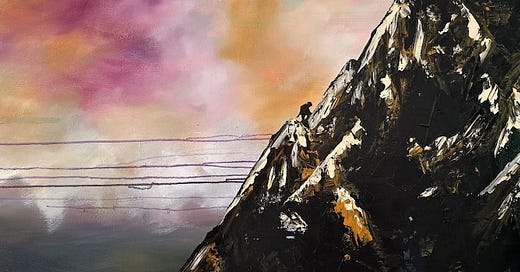Deciding What You "Want" To Do Once You Leave the Military
Why Embracing Uncertainty is the Fastest Route to Where You Want to Be.
If you aim to stand atop the Grand Teton, chances are you use a trail called "Garnet Meadows." If your goal is to stand atop the Middle Teton (one peak south of the grand), chances are you're also using Garnet Meadows, at least for the first 4.7 miles.
Weeks ago, I joined two friends in an attempt at the 13,700-foot Grand Teton. The climb took place on a beautiful Saturday afternoon with cool temperatures and a favorable weather forecast.
All went well for the first couple hours. Then somewhere around mile five, toward the back of Garnet Canyon, I couldn't help but notice something was off. In the Tetons, it’s normal for the trail to vanish and re-appear as you traverse the many boulder fields, however, I realized it’d been a half-hour since I’d seen any real signs of trail.
We should be seeing more people, I thought. More climbers coming toward us.
Finally, we ran into someone, a guide from Teton Mountaineering, and I asked him if we were on the right track?
"Depends." He told me. "If you're climbing the Middle Teton, you are."
Because I’d climbed the mountain previously, there was an unspoken agreement, I was the one responsible for the route.
I watched as the look on my buddy's face filled with disappointment.
Three-quarters of a mile back, we'd gone left where we should have turned right. Three-quarters of a mile might not sound like much, but when your goal requires 7K ft of elevation gain, a single mis-step can feel devastating.
Last week, I talked to a separating service member, a pilot from a demanding, highly sophisticated corner of aviation.
"How'd you know what you wanted to do when you got out?" she asked me.
"I don’t think I did." I told her. “Do you know what you want to do?”
She told me she planned to accept a position at a software company. "They do defense acquisition work," she said. “But I think my dream is to fly a bush plane in Alaska…”
I could tell she expected me to press back, do what you’d expect an ex-Navy SEAL with an affinity for skiing and climbing to do—say, "Follow your dream. Go be a Bush Pilot."
Instead I said, "There's probably no data on this, but if there was, it would say that whatever you decide, you'll likely do for a year or two and then move to something else. Don’t stress too much. You don't have to have the next thirty years figured out this week."
Whenever someone makes this point, you can feel disappointment coming through the screen– and rightly so. It takes a lot of work to get hired.
To be told that it's all temporary, isn’t good news.
When you leave the military, certainty is everything. When someone you know says, "You're getting out? What will you do?" We want an answer - a convenient one-line response that you can give. One that says, “I’m definitely moving toward greener pastures.”
On top of it all, civilians your age are a decade or more into established careers, demonstrating the idea that they've found what they "want" to do.
From what I can tell, the only way to solve this is to start moving, do what you’ve always done and start walking.
The difference between those who figure it out and those who don't is just a willingness to start and a willingness to be wrong.
"As you start to walk on the way, the way appears." - Rumi
My advice is to set your sights on:
Roles that demand your potential. For most, the military demanded 110% of who we are. Transitioning to a role that requires only 50%—70% of what you’re capable of leads to a lot of apathy, boredom, and wondering what your purpose is.
Roles that provide exposure. The hard truth is that you don't know what you don't know. If your first role post-service is temporary, the biggest thing you stand to gain is education. This includes technical skills of course, but more importantly, exposure to the many styles and cultures that exist within career. Knowing what you don't want might be as important as knowing what you do want.
Roles that encourage balance. Many depart the military to invest more as parents, spouses, and friends. We want to make up for lost time spent overseas and on training trips. Don't make the mistake of doing something that has the opposite effect. If you realize what you want is to make as much money as possible, there's still time for that.
That day in the Tetons, when I realized we'd made a wrong turn - that we were five hundred feet up the Middle Teton and off route, it crossed my mind that we should just keep going. To just summit the Middle instead of the Grand.
Middle Teton is a worthy route; it's challenging and has characteristics similar to the Grand.
But it wasn't our mountain. It wasn’t the highest and best use of our day.
Rather than continuing and instead of backtracking, we cut our own path through brutal terrain, up and down and up again, until eventually we were back on the right trail.
We made it to the top, not because we were perfect or even efficient, but because we kept walking. We walked and walked, and when we found ourselves off trail, we pivoted and walked some more.
Eventually finding our way.






I couldn't agree more Matt. Optionality.
The GI Bill is still such a great tool, especially if you don’t have an identified path. College isn’t for everyone, but you can get a lot of exposure to different fields very quickly and figure out which ones work.